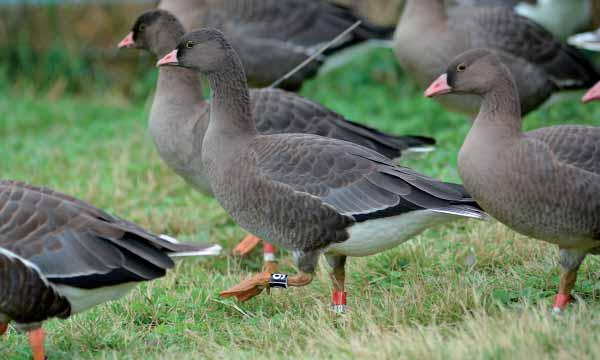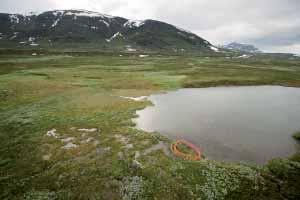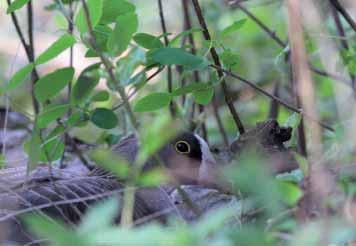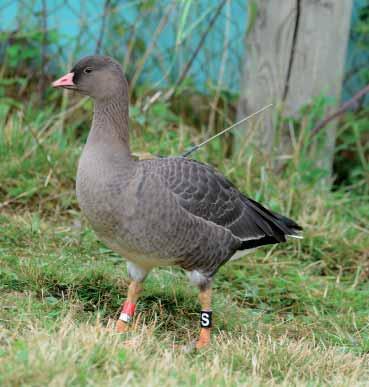
3 minute read
A wild goose chase with a difference .....................................John Grant
John Grant Colour-ringed Lesser Whitefronted Geese in Sweden, one of which is fitted with a satellite tracking device.
A Lesser Whitefronted Goose pen in Swedish Lapland.
A wild goose chase with a difference
For some birders, the arrival in Suffolk in December 2014 of four Lesser Whitefronted Geese from a Swedish conservation programme that involves captive breeding and release raised an old chestnut of a conundrum - to tick or not to tick. Some rather cynical, sniffy remarks about the birds’ tickability emerged from the more narrow-minded and strictly list-orientated among us, but for many observers it was more a case of simply enjoying the quartet during their Suffolk sojourn. The occurrence also highlighted the marvels of modern technology - one of the geese was fitted with a satellite tracking device - and also enabled many of us to feel privileged to be part of such an international ornithological event.
The fascinating story began with an email sent on December 31 to the RSPB at Minsmere by the Swedish Lesser Whitefronted Goose Project. The message astonished RSPB staff as it broke the news to them that satellite tracking had shown that a Lesser Whitefronted Goose from the project had roosted on the Scrape on the night of December 30 after having spent some time during the day on an area near Eastbridge. This one clearly had gone under the radar, so to speak, as no visitor or staff member had reported seeing it. Immediate searches of the reserve and neighbouring areas proved fruitless but on that afternoon the ever-diligent David Fairhurst relocated the goose at North Warren – and to his amazement it was accompanied by three others!
Swedish Lesser Whitefronted Goose Project

The foursome became moderately famous, prompting a mini-twitch, and satellitegathered data showed that they frequented Suffolk Wildlife Trust’s Hazlewood Marshes nature reserve and crossed over the River Alde to Sudbourne Marshes, as well as returning to North Warren at times during their brief visit to Suffolk. They were last reported by observers at the latter site at 1500hrs on January 3, but tracking data showed that they then headed out to sea over Orford Ness, in a south-easterly direction - heading for well-known goose hotspots in Belgium, where some 40,000 “ansers” were gathered. In late February they were still in Belgium, having frequented areas to the east of Bruges, just to the south of Zeebrugge and also further south-east, near Vleteren. At times they were relatively close to 25 wild Lesser Whitefronts that were wintering around Oudeland von Strijen in The Netherlands. The Swedish Lesser Whitefronted Goose Project’s director, Dr. Niklas Liljebäck, was clearly delighted by the international co-operation that was shown as events unfolded. On several occasions he emailed a small band of Suffolk observers who fed back to him information about the quartet. It became evident that the foursome were offspring from wild-caught Lesser Whitefronted Geese that had been caught in a breeding area north of the Ural Mountains. They were released on August 1, 2014, in the breeding area of wild Lesser Whitefronts in Swedish Lapland. Dr Liljebäck, who is based in Nyköping, Sweden, wrote: ”Unfortunately, this flock lost contact with their wild conspecifics early and went to the Norwegian coast. The flock contains birds of three different broods and the constellation of sexes makes this flock highly interesting for us. If they are able to come back to the breeding area in Sweden they may become a valuable recruitment to the wild population. From my colleagues that have had the privilege to have visited Minsmere, I have understand that the birds could not have chosen a better place to take a break or spend the winter.” Hear, hear to that. And as for the “to-tickor-not-to-tick” question, who knows? More to the point, in the grand scheme of things, when we’ve been privileged to have been part of such a great story, what does it matter?
A female Lesser Whitefronted Goose on her nest in the Swedish conservation programme A close-up of a Lesser Whitefronted Goose fitted with a satellite tracking device.

Swedish Lesser Whitefronted Goose Project

Swedish Lesser Whitefronted Goose Project










